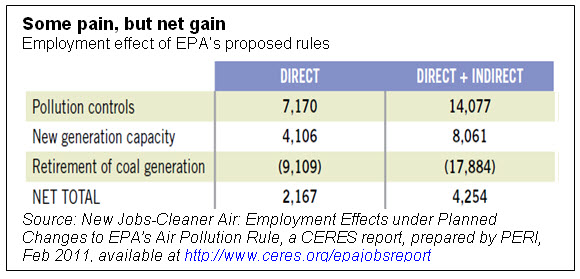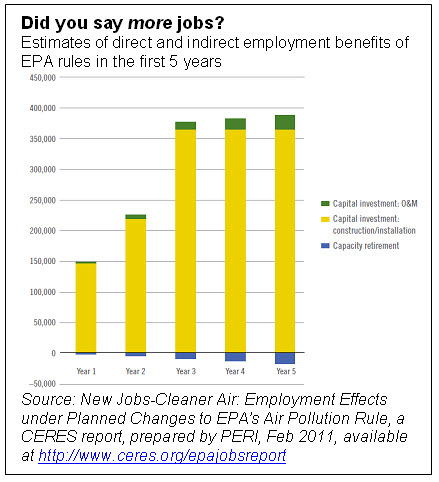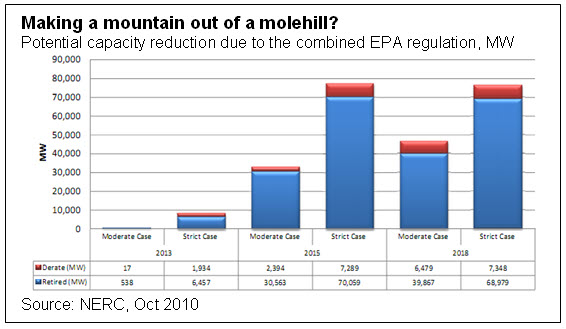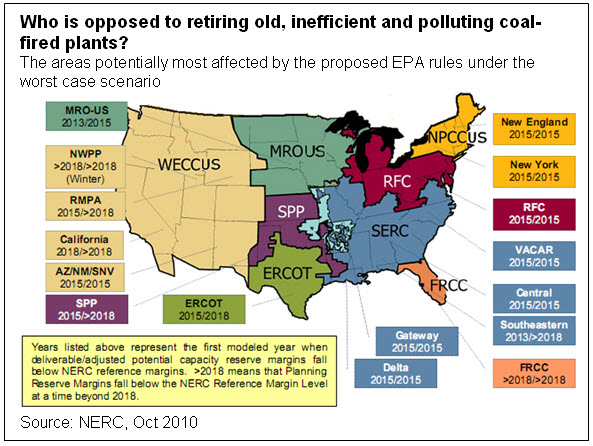This is a sample article from the March 2011 issue of EEnergy Informer.
Proposed rules will clean the air and create more jobs, if you believe the results
The current debate on the proper role, function, scope and cost of regulations in the preceding article singled out the US Environmental Protection Agency (EPA) as the biggest culprit, by a wide margin. Does this mean that EPA is doing a good job in issuing new regulations and aggressively enforcing them — or does it suggest that it has gone too far and needs to be reigned in? The answer depends on whom you ask.
A report published in February 2011 by CERES and prepared by the Political Economy Research Institute (PERI) at the University of Massachusetts concludes that air pollution rules proposed by the EPA targeted at the electric power sector will provide economic benefits and create additional jobs even if the distribution of the benefits are uneven across the US.

The report, New Jobs-Cleaner Air: Employment Effects under Planned Changes to EPA’s Air Pollution Rules, examines the jobs created through investments in pollution controls, new plant construction as well as the retirement of older, less efficient coal plants as the US transitions to a cleaner generation fleet over time. Among the key findings of the study is that the power sector will invest nearly $200 billion in capital improvements over the next five years resulting in the creation of an estimated 1.46 million jobs, roughly 290,000 on average in each of the next five years with Virginia, Tennessee, Illinois, North Carolina and Indiana among the biggest winners.

The study examined the job impacts under two Clean Air Act rules expected to be finalized in 2011: the Clean Air Transport Rule (CATR) focused on SOx and NOx emissions from 31 targeted states in the East and Midwest; and the Maximum Achievable Control Technology (MACT) rule, which will set limits on hazardous air pollutants such as mercury, arsenic, lead and hydrochloric acid, further described in Dec 2010 issue of this newsletter — What is the alternative to aging, inefficient and dirty coal?
Recent studies by the North American Electric Reliability Corp. (NERC) and others conclude that roughly 35 GW of aging, highly polluting and inefficient coal-fired generation could be retired in the Eastern Interconnection by 2015. The number varies depending on the time frame, the geographical region, and assumptions about the costs of meeting proposed EPA rules. It must be noted that many of these plants are already economically challenged due to low natural gas prices, reduced electricity demand and other factors, suggesting that they would most likely be retired even without the proposed EPA rules.

Referring to these realities, David Foerter, executive director of the Institute of Clean Air Companies, a network of nearly 100 companies that make pollution monitoring and control technology equipment, suggests, “Now is the time to give Americans the clean, healthy air they deserve by putting American workers back on the job modernizing our electric generating fleet.”
Explaining the study’s counter-intuitive results, Mindy Lubber, president of CERES, points out that, “Americans can expect significant economic gains from implementing these new EPA rules in the form of highly-skilled, well-paying jobs that will help us clean up and modernize the nation’s power plant fleet.” CERES represents a coalition of investors, environmental groups and public interest organizations working with companies to address sustainability challenges such as global climate change. CERES also directs the Investor Network on Climate Risk (INCR), a network of 98 investors with $9.5 trillion of assets focused on the business impacts of climate change.

Reinforcing the same message, Dr. James Heintz, PERI’s Associate Director and the study’s lead author says, “Given the state of the economy, many are concerned about the new air pollution regulations’ impact on jobs.”
“Our research demonstrates that robust employment growth will take place alongside efforts to reduce harmful emissions.”
He adds, “The Eastern and Midwestern states we studied will experience a net gain of jobs, once all investments in pollution control and new generation capacity are completed. We need to move beyond the outdated idea that environmental protection compromises the ongoing growth of our economy.”
EPA bashers who argue new regulations will stifle economic growth are not likely to be convinced by a study funded by an environmental leaning group of investors. The EPA’s own analysis concluded that the proposed Clean Air Transport Rule alone will yield $120-290 billion in annual health and welfare benefits in 2014, including the value of avoiding an estimated 14 to 36,000 premature deaths.
Due to increased pressures from all quarters, EPA has been forced to water down its proposed regulations. It does not really matter what the costs and benefits may be.

